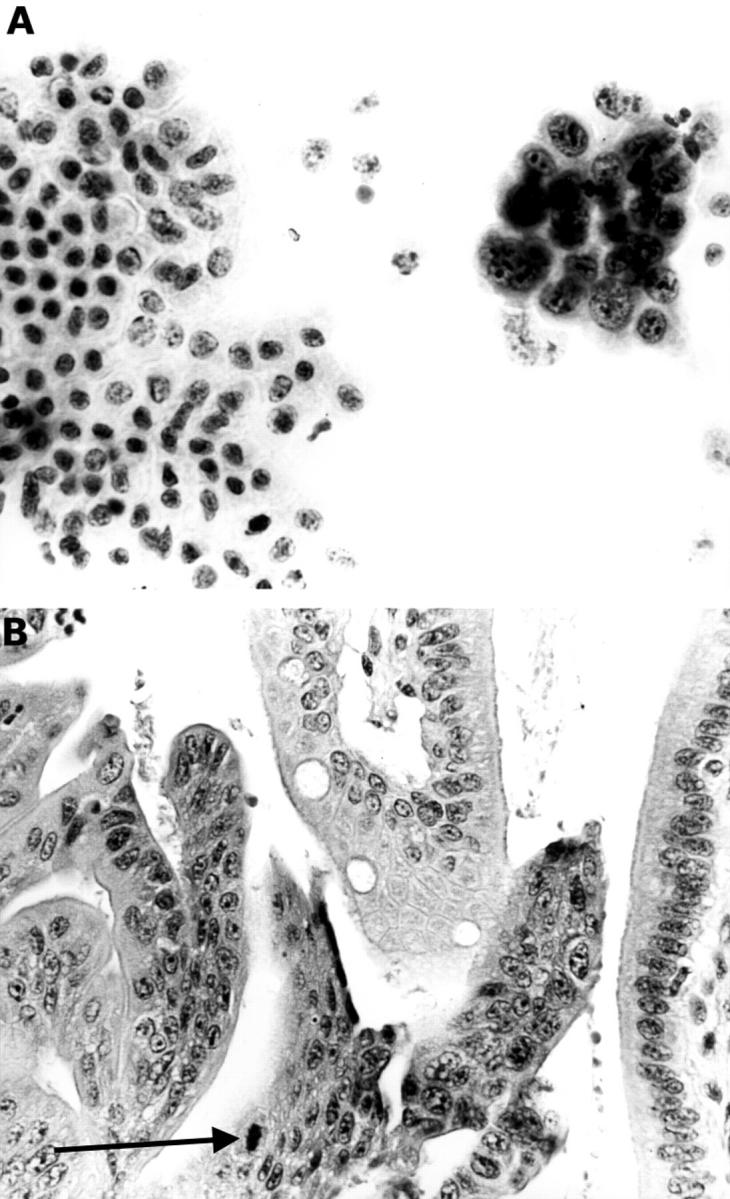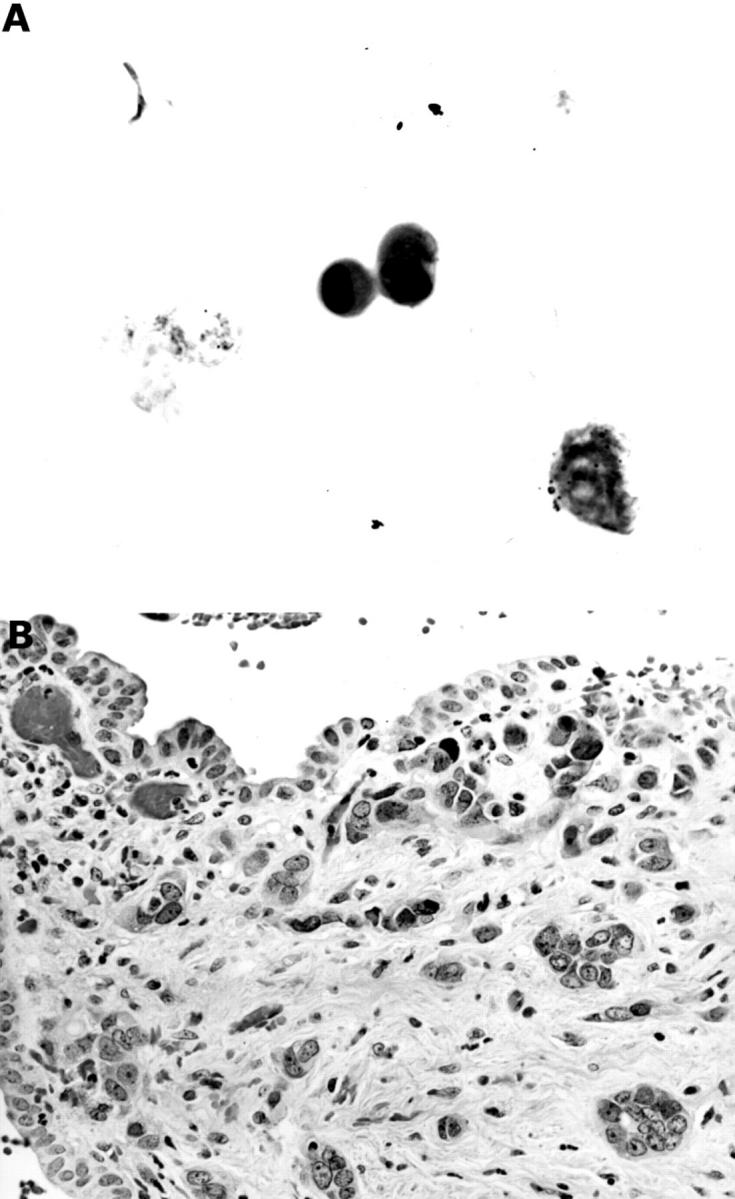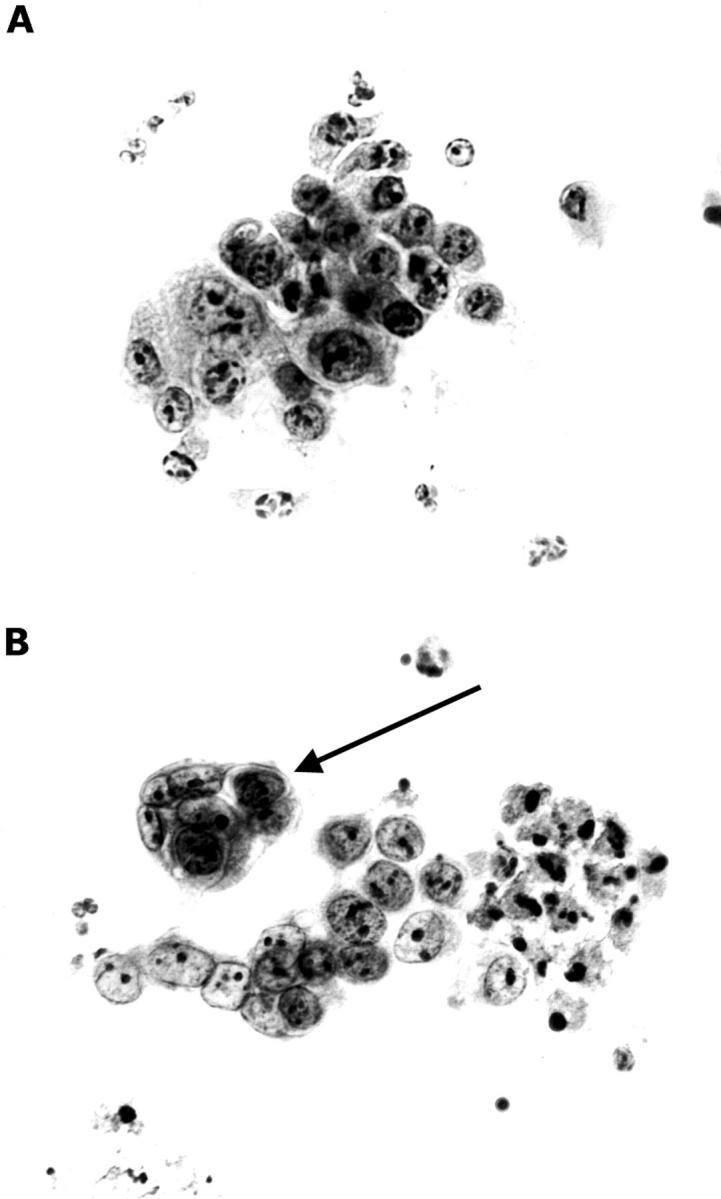Abstract
Aims
To assess the accuracy of brush cytology in patients investigated for pancreatico-biliary strictures.Methods
All pancreatico-biliary brush cytology specimens submitted from two major teaching hospitals over a 6.5 year period were reviewed. Four hundred and forty eight satisfactory specimens from 406 patients with adequate clinical and/or pathological follow up data were examined in the study period.Results
Two hundred and forty six patients (60.6%) were shown to have neoplastic strictures. One hundred and forty seven tumours were identified cytologically, including 87 of 146 pancreatic carcinomas, 29 of 47 cholangiocarcinomas, one of one bile duct adenoma, four of seven carcinomas of the gallbladder, eight of 13 ampullary carcinomas, two of three ampullary adenomas, 10 of 16 malignancies of undetermined origin, none of two islet cell tumours, one of three hepatocellular carcinomas, and five of eight metastatic tumours. The three adenomas identified on brush cytology could not be distinguished from adenocarcinoma morphologically. One hundred and sixty patients (39.4%) had benign strictures, most often as a result of chronic pancreatitis and bile duct stones. There were three false positive cytological diagnoses mainly as a result of the misinterpretation of cases with relatively scant and/or degenerative atypical epithelial cells. Forty one cases were reported as atypical or suspicious of malignancy on brush cytology, of which 29 were ultimately shown to have carcinoma. The overall diagnostic sensitivity and specificity were 59.8% and 98.1%, respectively. The sensitivity increased from 44.3% in the initial third of cases to 70.7% in the final third of cases examined in the series.Conclusions
Brush cytology, in conjunction with other clinical and radiological investigations, is a useful technique in the assessment of patients with suspected pancreatico-biliary neoplasia.Free full text

Brush cytology in the assessment of pancreatico–biliary strictures: a review of 406 cases
Abstract
Aims—To assess the accuracy of brush cytology in patients investigated for pancreatico–biliary strictures.
Methods—All pancreatico–biliary brush cytology specimens submitted from two major teaching hospitals over a 6.5 year period were reviewed. Four hundred and forty eight satisfactory specimens from 406 patients with adequate clinical and/or pathological follow up data were examined in the study period.
Results—Two hundred and forty six patients (60.6%) were shown to have neoplastic strictures. One hundred and forty seven tumours were identified cytologically, including 87 of 146 pancreatic carcinomas, 29 of 47 cholangiocarcinomas, one of one bile duct adenoma, four of seven carcinomas of the gallbladder, eight of 13 ampullary carcinomas, two of three ampullary adenomas, 10 of 16 malignancies of undetermined origin, none of two islet cell tumours, one of three hepatocellular carcinomas, and five of eight metastatic tumours. The three adenomas identified on brush cytology could not be distinguished from adenocarcinoma morphologically. One hundred and sixty patients (39.4%) had benign strictures, most often as a result of chronic pancreatitis and bile duct stones. There were three false positive cytological diagnoses mainly as a result of the misinterpretation of cases with relatively scant and/or degenerative atypical epithelial cells. Forty one cases were reported as atypical or suspicious of malignancy on brush cytology, of which 29 were ultimately shown to have carcinoma. The overall diagnostic sensitivity and specificity were 59.8% and 98.1%, respectively. The sensitivity increased from 44.3% in the initial third of cases to 70.7% in the final third of cases examined in the series.
Conclusions—Brush cytology, in conjunction with other clinical and radiological investigations, is a useful technique in the assessment of patients with suspected pancreatico–biliary neoplasia.
Key Words: brush cytology • pancreatico-biliary strictures • pancreatico-biliary neoplasia
Full Text
Selected References
These references are in PubMed. This may not be the complete list of references from this article.
- Ettinghausen SE, Schwartzentruber DJ, Sindelar WF. Evolving strategies for the treatment of adenocarcinoma of the pancreas. A review. J Clin Gastroenterol. 1995 Jul;21(1):48–60. [Abstract] [Google Scholar]
- Thuluvath PJ, Rai R, Venbrux AC, Yeo CJ. Cholangiocarcinoma: a review. Gastroenterologist. 1997 Dec;5(4):306–315. [Abstract] [Google Scholar]
- Kurzawinski T, Deery A, Davidson BR. Diagnostic value of cytology for biliary stricture. Br J Surg. 1993 Apr;80(4):414–421. [Abstract] [Google Scholar]
- Foutch PG. Diagnosis of cancer by cytologic methods performed during ERCP. Gastrointest Endosc. 1994 Mar-Apr;40(2 Pt 1):249–252. [Abstract] [Google Scholar]
- Warshaw AL. Implications of peritoneal cytology for staging of early pancreatic cancer. Am J Surg. 1991 Jan;161(1):26–30. [Abstract] [Google Scholar]
- Leach SD, Rose JA, Lowy AM, Lee JE, Charnsangavej C, Abbruzzese JL, Katz RL, Evans DB. Significance of peritoneal cytology in patients with potentially resectable adenocarcinoma of the pancreatic head. Surgery. 1995 Sep;118(3):472–478. [Abstract] [Google Scholar]
- Merchant NB, Conlon KC, Saigo P, Dougherty E, Brennan MF. Positive peritoneal cytology predicts unresectability of pancreatic adenocarcinoma. J Am Coll Surg. 1999 Apr;188(4):421–426. [Abstract] [Google Scholar]
- Kocjan G, Smith AN. Bile duct brushings cytology: potential pitfalls in diagnosis. Diagn Cytopathol. 1997 Apr;16(4):358–363. [Abstract] [Google Scholar]
- Lee JG, Leung JW, Baillie J, Layfield LJ, Cotton PB. Benign, dysplastic, or malignant--making sense of endoscopic bile duct brush cytology: results in 149 consecutive patients. Am J Gastroenterol. 1995 May;90(5):722–726. [Abstract] [Google Scholar]
- Ponchon T, Gagnon P, Berger F, Labadie M, Liaras A, Chavaillon A, Bory R. Value of endobiliary brush cytology and biopsies for the diagnosis of malignant bile duct stenosis: results of a prospective study. Gastrointest Endosc. 1995 Dec;42(6):565–572. [Abstract] [Google Scholar]
- Sturm PD, Rauws EA, Hruban RH, Caspers E, Ramsoekh TB, Huibregtse K, Noorduyn LA, Offerhaus GJ. Clinical value of K-ras codon 12 analysis and endobiliary brush cytology for the diagnosis of malignant extrahepatic bile duct stenosis. Clin Cancer Res. 1999 Mar;5(3):629–635. [Abstract] [Google Scholar]
- Logrono R, Kurtycz DF, Molina CP, Trivedi VA, Wong JY, Block KP. Analysis of false-negative diagnoses on endoscopic brush cytology of biliary and pancreatic duct strictures: the experience at 2 university hospitals. Arch Pathol Lab Med. 2000 Mar;124(3):387–392. [Abstract] [Google Scholar]
- Sawada Y, Gonda H, Hayashida Y. Combined use of brushing cytology and endoscopic retrograde pancreatography for the early detection of pancreatic cancer. Acta Cytol. 1989 Nov-Dec;33(6):870–874. [Abstract] [Google Scholar]
- Ishimaru S, Itoh M, Hanada K, Tsuchida A, Iwao T, Kajiyama G. Immunocytochemical detection of p53 protein from pancreatic duct brushings in patients with pancreatic carcinoma. Cancer. 1996 Jun 1;77(11):2233–2239. [Abstract] [Google Scholar]
- McGuire DE, Venu RP, Brown RD, Etzkorn KP, Glaws WR, Abu-Hammour A. Brush cytology for pancreatic carcinoma: an analysis of factors influencing results. Gastrointest Endosc. 1996 Sep;44(3):300–304. [Abstract] [Google Scholar]
- Desa LA, Akosa AB, Lazzara S, Domizio P, Krausz T, Benjamin IS. Cytodiagnosis in the management of extrahepatic biliary stricture. Gut. 1991 Oct;32(10):1188–1191. [Europe PMC free article] [Abstract] [Google Scholar]
- de Peralta-Venturina MN, Wong DK, Purslow MJ, Kini SR. Biliary tract cytology in specimens obtained by direct cholangiographic procedures: a study of 74 cases. Diagn Cytopathol. 1996 Jun;14(4):334–348. [Abstract] [Google Scholar]
- Layfield LJ, Wax TD, Lee JG, Cotton PB. Accuracy and morphologic aspects of pancreatic and biliary duct brushings. Acta Cytol. 1995 Jan-Feb;39(1):11–18. [Abstract] [Google Scholar]
- Ryan ME, Baldauf MC. Comparison of flow cytometry for DNA content and brush cytology for detection of malignancy in pancreaticobiliary strictures. Gastrointest Endosc. 1994 Mar-Apr;40(2 Pt 1):133–139. [Abstract] [Google Scholar]
- Bardales RH, Stanley MW, Simpson DD, Baker SJ, Steele CT, Schaefer RF, Powers CN. Diagnostic value of brush cytology in the diagnosis of duodenal, biliary, and ampullary neoplasms. Am J Clin Pathol. 1998 May;109(5):540–548. [Abstract] [Google Scholar]
- Stewart CJ, Stephen MR, Ferrier RK. Hepatocellular carcinoma diagnosis in bile duct brush cytology. Diagn Cytopathol. 1998 Aug;19(2):149–150. [Abstract] [Google Scholar]
- Mansfield JC, Griffin SM, Wadehra V, Matthewson K. A prospective evaluation of cytology from biliary strictures. Gut. 1997 May;40(5):671–677. [Europe PMC free article] [Abstract] [Google Scholar]
- Iwao T, Hanada K, Tsuchida A, Hirata M, Eguchi N, Kajiyama G. The establishment of a preoperative diagnosis of pancreatic carcinoma using cell specimens from pancreatic duct brushing with special attention to p53 mutations. Cancer. 1998 Apr 15;82(8):1487–1494. [Abstract] [Google Scholar]
- van Es JM, Polak MM, van den Berg FM, Ramsoekh TB, Craanen ME, Hruban RH, Offerhaus GJ. Molecular markers for diagnostic cytology of neoplasms in the head region of the pancreas: mutation of K-ras and overexpression of the p53 protein product. J Clin Pathol. 1995 Mar;48(3):218–222. [Europe PMC free article] [Abstract] [Google Scholar]
- Rabinovitz M, Zajko AB, Hassanein T, Shetty B, Bron KM, Schade RR, Gavaler JS, Block G, Van Thiel DH, Dekker A. Diagnostic value of brush cytology in the diagnosis of bile duct carcinoma: a study in 65 patients with bile duct strictures. Hepatology. 1990 Oct;12(4 Pt 1):747–752. [Abstract] [Google Scholar]
- Rupp M, Hawthorne CM, Ehya H. Brushing cytology in biliary tract obstruction. Acta Cytol. 1990 Mar-Apr;34(2):221–226. [Abstract] [Google Scholar]
- Stewart CJ, Carter R, Imrie CW, Foulis AK. Brush cytology of intraduct papillary mucinous neoplasm of the pancreas. Cytopathology. 1997 Oct;8(5):343–348. [Abstract] [Google Scholar]
Figures and Tables

Figure 2 Bile duct adenoma. (A) Brush cytology showing a loosely cohesive and crowded epithelial group exhibiting malignant nuclear features. A group of normal ductal cells is present for comparison (left). (B) Resection showing papillary adenoma with focal high grade dysplasia. Note the mitotic figure (arrow).
Articles from Journal of Clinical Pathology are provided here courtesy of BMJ Publishing Group
Full text links
Read article at publisher's site: https://doi.org/10.1136/jcp.54.6.449
Read article for free, from open access legal sources, via Unpaywall:
https://jcp.bmj.com/content/jclinpath/54/6/449.full.pdf
Citations & impact
Impact metrics
Citations of article over time
Alternative metrics
Smart citations by scite.ai
Explore citation contexts and check if this article has been
supported or disputed.
https://scite.ai/reports/10.1136/jcp.54.6.449
Article citations
Implementing Massive Parallel Sequencing into Biliary Samples Obtained through Endoscopic Retrograde Cholangiopancreatography for Diagnosing Malignant Bile Duct Strictures.
Int J Mol Sci, 25(17):9461, 30 Aug 2024
Cited by: 0 articles | PMID: 39273408 | PMCID: PMC11395203
Diagnostic pitfalls and the value of fluorescence in situ hybridization as an adjunct to cytologic evaluation of bile duct brushings in patients with primary sclerosing cholangitis.
Diagn Cytopathol, 51(2):117-122, 01 Oct 2022
Cited by: 1 article | PMID: 36181472 | PMCID: PMC10092285
Use of Endoscopic Scraper and Cell Block Technique as a Replacement for Conventional Brush for Diagnosing Malignant Biliary Strictures.
Cancers (Basel), 14(17):4147, 27 Aug 2022
Cited by: 3 articles | PMID: 36077683 | PMCID: PMC9454915
Pronounced squamous cell contamination in biliary tract cytology: A diagnostic pitfall.
Diagn Cytopathol, 50(11):E320-E324, 25 Jun 2022
Cited by: 1 article | PMID: 35751519 | PMCID: PMC9796303
Endoscopic Ultrasound Plus Endoscopic Retrograde Cholangiopancreatography Based Tissue Sampling for Diagnosis of Proximal and Distal Biliary Stenosis Due to Cholangiocarcinoma: Results from a Retrospective Single-Center Study.
Cancers (Basel), 14(7):1730, 29 Mar 2022
Cited by: 3 articles | PMID: 35406502 | PMCID: PMC8997048
Go to all (111) article citations
Similar Articles
To arrive at the top five similar articles we use a word-weighted algorithm to compare words from the Title and Abstract of each citation.
Endoscopic brush cytology from the biliary duct system is still valuable.
Dan Med J, 60(7):A4656, 01 Jul 2013
Cited by: 8 articles | PMID: 23809967
Brush cytology of ductal strictures during ERCP.
Acta Gastroenterol Belg, 63(3):254-259, 01 Jul 2000
Cited by: 51 articles | PMID: 11189981
Biliary brush cytology in the assessment of biliary strictures at a tertiary center in Iran.
Asian Pac J Cancer Prev, 12(10):2793-2796, 01 Jan 2011
Cited by: 16 articles | PMID: 22320994
Brush cytology during ERCP for the diagnosis of biliary and pancreatic malignancies.
Gastrointest Endosc, 40(2 pt 1):140-145, 01 Mar 1994
Cited by: 111 articles | PMID: 8013810







